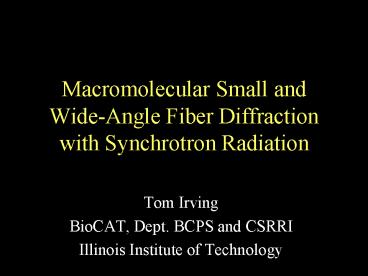Macromolecular Small and Wide-Angle Fiber Diffraction with Synchrotron Radiation - PowerPoint PPT Presentation
1 / 55
Title: Macromolecular Small and Wide-Angle Fiber Diffraction with Synchrotron Radiation
1
Macromolecular Small and Wide-Angle Fiber
Diffraction with Synchrotron Radiation
- Tom Irving
- BioCAT, Dept. BCPS and CSRRI
- Illinois Institute of Technology
2
Scope of Lecture
- Why do Fiber Diffraction?
- Physical Principles
- Experimental methods
- Applications
- Advantages of Third Generation Synchrotrons for
Fiber Diffraction
3
References
- Basics C. Cantor and P. Schimmel Biophysical
Chemistry part II Techniques for the study of
Biological Structure and Function Chapter 14.
Freeman, 1980 - A terrific introduction to helical diffraction
theory and muscle diffraction John Squire The
Structural Basis of Muscular Contraction Plenum,
1981 - The classic workB.K. Vainshtein Diffraction of
X-rays by Chain Molecules Elsevier, 1966.
4
More references
- Good introduction to Fiber crystallography
- Chandrasekaran, R. and Stubbs, G. (2001). Fiber
diffraction. in International Tables for
Crystallography, Vol. F Crystallography of
Biological Macromolecules (Rossman, M.G. and
Arnold, E., eds.), Kluwer Academic Publishers,
The Netherlands, 444-450.
5
Why Fiber Diffraction ?
- Atomic level structures from crystallography or
NMR gold standard for structural inferences - Large class of fibrous proteins
- Actin, myosin, intermediate filaments,
microtubules, bacterial flagella, filamentous
viruses, collagenous connective tissue - Difficult to crystallize but can be induced to
form oriented assemblies - Some systems such as muscle and tendon naturally
form such assemblies
6
Fibers Usually Hexagonally Packed
7
Hexagonal Lattice
u
y
x
8
Ewald Sphere
k a
2 ?
1
h a
?
9
Fiber Pattern Insect Muscle
Equator
10
Fiber Cross-section
Diffraction
X-rays
Complete Statistical rotation 1,0 1,0 0,1
0,1 1,1 1,1 1,1 1,1
11
A
B
C
Ordering in Fibers A - Crystalline fiber B
Semicrystalline Fiber C Non-crystalline fiber
ltI(s)gt ltFm(S)FL(S)2gt
Average over all molecular and lattice
orientations
12
Fiber Pattern Insect Muscle
Equator
13
Geometry of Fiber Patterns
14
Fibrous Proteins Usually Show Helical Symmetry
P pitch p subunit axial translation
distance R true repeat distance
15
Diffraction from a Continuous Helix
16
Bessel Functions and Diffraction from a Helix
17
Rosalind Franklins Pattern from B-DNA
Franklin Gosling, 1953Nature 171740
18
Diffraction from a Discontinous Helix
19
Discontinuous Helix with Non-integral
Subunits/Turn
20
Helical Selection Rule
- Bessel functions that contribute to a given layer
line depend on helical parameters - For a helix of pitch P with an axial subunit
displacement of p - and u subunits in t turns of a helix
- Allowed Bessel functions (of order n) on layer
line l are - l mu nt
- m is an integer indicating successive meridional
reflections
21
Crystals of Helical Molecules
22
Crystalline Forms of DNA
23
Multi-Stranded Helices
If N strands Only every Nth Layer -line allowed
24
Fiber Diffraction Often Just Used to Find Gross
Molecular Parameters
- In many cases one can make structural inferences
without a full-blown structure solution - Helical parameters in Polyamino-acids and nucleic
acids - Topology of viruses and other large molecular
complexes - Test hypotheses concerning influence of
inter-filament lattice spacing
25
Rosalind Franklins Pattern from B-DNA
M
Layer lines (L) separated by 34 Å nm Meridional
(M) reflection at 3.4 Å gt 10 residues/turn
L
M
Franklin Gosling, 1953 Nature 171740
26
Diffraction from Poly L-Alanine -?-helix
1.5 Å/residue Pitch 5.4 Å 18 residues/5
turns Layer lines every (5.4 l/5)-1 l18m5n
27
Sometimes a modeling approach is taken
28
(No Transcript)
29
Fiber Crystallography
- Most fiber structures result of model building
studies - There have been a relatively small number of
Fiber structure solutions. - TMV by Caspar and others
- High resolution structure by Keichi Namba on
bacterial flagella (Yamashita et al., 1998 Nature
SB) aligned by high magnetic fields - Orgel et al. (2001 Structure) -first MIR
structure of a natural fiber - Type I Collagen
from rat tail
30
Tobacco mosaic virus
31
Fiber diffraction pattern of gold-labeled rat
tail tendon Collected native, gold, iodide
patterns Orgel et al. Structure 91-20, 2001
32
Background subtracted image of row lines showing
closely -spaced but resolved diffraction spots
33
Two unit cells of the fiber structure of rat tail
(Type I) collagen. 67 nm long axis has been
compressed 12 x for display purposes Map is 20 Å
wide Resolution is 5.4 Å vertically and 10 Å
horizontally
34
Muscle Diffraction
35
Hierarchy of Muscle Structure
36
Muscle Filament Substructure
37
Sliding Filament Theory of Muscle Contraction
38
(No Transcript)
39
(No Transcript)
40
(No Transcript)
41
Muscle Filament Lattice
42
Layer Line Pattern From Striated Muscle
43
Relaxed
Isometric
After quick release
44
Cardiac Muscle
45
(No Transcript)
46
(No Transcript)
47
Synchrotrons and Fiber Diffraction
- Early work all done with conventional sources -
why need synchrotron? - Patterns weak, have high backgrounds, frequently
have multiple closely spaced lattices - Studies benefit from greatly increased beam
quality - Greatly increased flux permits time-resolved
experiments
48
(No Transcript)
49
Undulator Beamline Performance
- Total X-ray flux 1-2.5 x1013 photons/s
- Focal spot size ranges from lt 40 µm vertical and
lt 200 µm horizontal to 3 x 1.5 mm - First order resolution gt 1500 Å
- Order to order resolution gt 10000 Å
50
diffraction pattern from oriented
sol odontoglossum ringspot virus BioCAT 2001
51
Functional integration time resolved
52
Diffraction features very similar in all insect
muscles Layer lines orders of 232 nm long
repeat Split 14.5 and 7.2 nm reflections from
axial stagger of filaments in flies. Note First
row line spot on 19.3 nm layer line
6
53
Fly Flight simulator
- Visual field simulator
- Wing-beat phase trigger
- Rapid shutter
54
(No Transcript)
55
Analysis Software
- Rate limiting step is data analysis
- Long tradition of rolling your own
- CCP 13 project http//www.ccp13.ac.uk
- Comprehensive data extraction suite
- Complementary NSF RCN Stubbs (Vanderbilt) PI
will add angular deconvolution, other features to
suite

